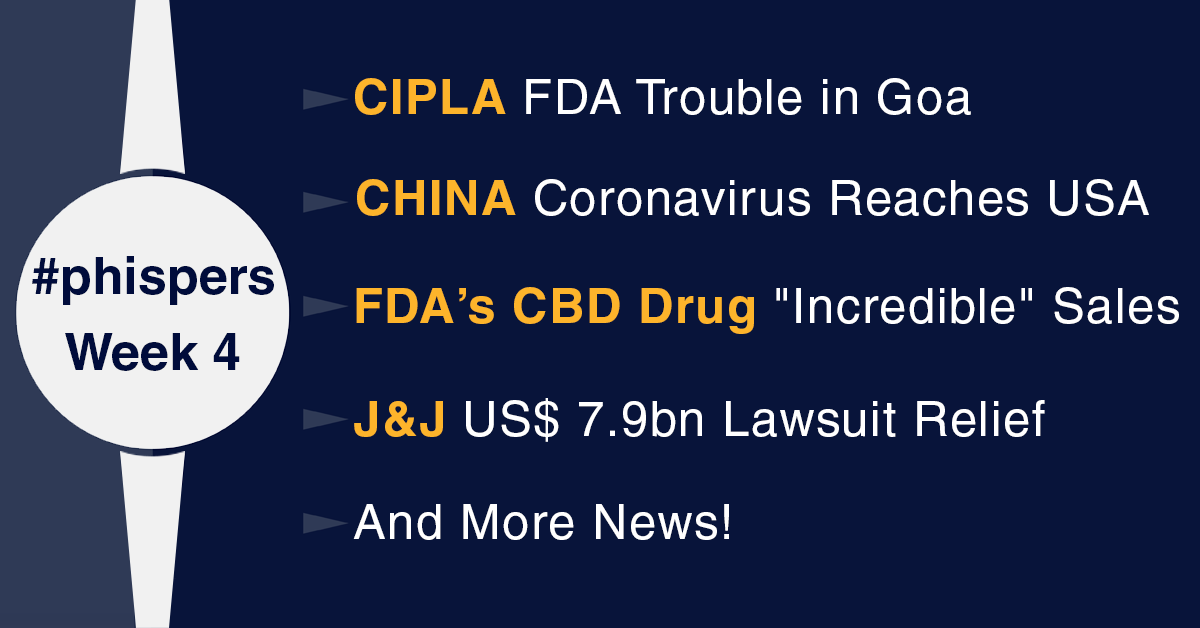Cipla in FDA trouble; FDA-backed cannabis drug posts strong sales in launch year

This week, Phispers brings you an update on the mysterious respiratory infection as over 500 people get infected by the coronavirus worldwide, killing 17 people in China.
Companies like Celltrion, AstraZeneca and Astella have announced major investments in drug manufacturing, with Celltrion planning to invest US$ 514 million over five years in a new plant in Wuhan.
Cipla’s Goa facility ran into trouble with the FDA while a subsidiary of Indian drugmaker Biocon cleared an FDA inspection without an observation.
A report suggests 2020 will see robust growth in the CDMO market with the likelihood of more M&As.
The first FDA-backed cannabis-based drug — Epidiolex — posted strong sales in its launch year.
And in the US, a court slashed punitive damages award by over US$ 7.99 billion in a case against Johnson & Johnson’s Risperdal.
Cipla in FDA
trouble; Biocon arm clears FDA inspection without observations
Indian drugmaker Cipla informed the bourses that its finished pharmaceuticals manufacturing facility in Goa had been classified as Official Action Indicated (OAI) by the US Food and Drug Administration (FDA).
The facility was inspected in September 2019, following which the FDA investigators had issued a 38-page Form 483.
During the 11-day inspection, the FDA uncovered inadequate cleaning practices. During a facility walkthrough there were multiple instances where layers of colored drug product residue were observed on the inside surfaces of air outlet ducts.
In addition, the aseptic filling areas were not operating as per the established classification and were found to be deficient in systems for maintaining equipment used to control the aseptic conditions.
Cipla’s Goa unit generates 25 to 30 percent of its US business. However, the firm has stated that this development will not have any material impact on its US business.
Cipla also informed the bourses that it had received an EIR (Establishment Inspection Report) from the FDA for its Patalganga manufacturing facility in Maharashtra. The inspection was conducted from November 4 to 13, 2019.
Meanwhile, Indian drugmaker Biocon shared a positive development that a pre-approval inspection of the Bengaluru facility of its subsidiary — Biocon Pharma — conducted by the FDA was concluded with zero observations.
The US agency had conducted a pre-approval inspection of the oral solid dosage manufacturing facility of Biocon Pharma, which was triggered by the submission of an abbreviated new drug application (ANDA), Biocon said in a regulatory filing.
“The inspection of the Bengaluru facility, which took place between January 13 and January 17, 2020, concluded with zero observations and no Form 483 was issued,” the company told stock exchanges.
Strides Pharma Science Ltd (Strides) said its arm has received an EIR from FDA for its Florida facility in the US. The inspection of the facility was conducted in December last year.
The facility is one of the very few manufacturing facilities in the US with a soft gel capsule (SGC) manufacturing suite for formulations with containment needs, it said.
Meanwhile, a news report pointed out that the total number of OAI classifications of the FDA continued to fall in 2019. A majority of the OAI’s issued by the FDA last year were for US-based facilities.
FDA’s inspection classification database for the drug, device and biologic centers revealed that China and India’s share of the overall OAI classifications total has remained relatively steady over the past five years, while the US has seen a decline in the number of such classifications.
Wuhan’s coronavirus reaches US; 17 dead, over 540 cases reported worldwide
The mysterious respiratory infection that has killed 17 people and affected over 500 across Asia reached the United States with a man in his 30s being found to be infected with the Wuhan coronavirus.
Besides US, cases of the mysterious infection have been reported in Macao, Taiwan, South Korea, Thailand and Japan. Latest reports suggest Wuhan has been sealed off as China has cut off all urban transport networks into and out of Wuhan.
“Without a special reason, city residents should not leave Wuhan,” the central city’s special command centre to combat the virus said.
Though the World Health Organization (WHO) has stepped back from declaring the outbreak ‘a public health emergency of international concern,’ it will meet again to discuss more evidence from its teams on the ground.
“This is an evolving and complex situation,” said Dr Tedros Adhanom Ghebreyesus, the director-general of the WHO. According to Chinese authorities, more than 540 people have been taken to hospital with breathing difficulties and 17 have died, all in Hubei province. Many more are thought to have developed a milder form of the illness.
In the US, the infected man is a resident of Snohomish County, Washington. He developed symptoms after returning from a trip to the region around Wuhan where the outbreak began. The US has announced expanded screenings for the infection at major airports. In addition to New York, Los Angeles and San Francisco, airports in Atlanta and Chicago will examine passengers arriving from Wuhan for signs of the illness. Other countries like the UK are also taking similar precautions.
The coronavirus is from the same family that caused over 700 deaths globally from SARS (severe acute respiratory syndrome) in 2002-03 and MERS (Middle East respiratory virus) in 2012. The committee said that the virus is mostly affecting older people, with 73 percent of patients over the age of 40.
Celltrion, AstraZeneca, Astellas announce
major manufacturing investments
The year began with a string of investment announcements by pharmaceutical companies. First, Celltrion, a Korean biosimilars maker, said it will invest US$ 514 million over five years on a new plant in Wuhan, the city in China from where the coronavirus outbreak is said to have originated.
The new facility in Wuhan — Celltrion’s first site in China — is designed to develop and manufacture biologics for the local market, as well as performing contract work for the emerging wave of Chinese biotechs.
According to Celltrion, this will be China’s biggest biologics facility at a capacity of 120,000 liters. The company is expected to hold a groundbreaking ceremony in April.
The company’s chairman, Jung-jin Seo, made this announcement at the recently held JP Morgan healthcare conference. “As we chart the company’s 2030 vision, the company hopes to launch one biosimilar product every year, reaching a total number of 18 products by 2030,” Seo said in a statement.
Biosimilars and value added medicines — known as ‘bioinnovatives’ (innovative biosimilars) — are set to be the key growth drivers for Celltrion in 2020.
Second, with the nearing of Brexit, British pharma major AstraZeneca is investing more in continental Europe, and cutting back in its home country.
AstraZeneca unveiled a US$ 520 million investment in France in manufacturing and R&D.
“The investment enables us to further build scientific collaborations in France, ensure our global manufacturing site in Dunkirk can continue to meet the evolving needs of the business and accelerate new technologies through a new European Innovation Hub,” AstraZeneca CEO Pascal Soriot said in a statement.
Third, Japan-based Astellas Pharma Inc has announced that it will construct a new manufacturing facility for active pharmaceutical ingredient (API) of Prograf (tacrolimus hydrate) in the Toyama Technology Center (in Toyoma, Japan) of Astellas Pharma Tech, a production subsidiary of Astellas.
The total construction cost will be approximately US$ 90.95 million (¥10.0 billion) and the construction of the facility is expected to be complete by August 2021.
2020 to see robust growth in CDMO market;
more M&As likely
As there is a greater willingness among drug companies to outsource , the year 2020 promises to be another strong year for contract development and manufacturing organizations (CDMOs).
According to DCAT Value Chain Insights, many CDMOs experienced double-digit growth in 2019. Since many of the conditions that made 2019 successful remain in place, 2020 also poses to be a good year, the report added.
On the approval front, biopharma companies are making broad use of FDA’s expedited approval pathways, including the breakthrough and fast track designations, and the FDA remains committed to improving the drug-approval process through its New Drugs Regulatory Program Modernization initiative.
The FDA approved 48 innovative products, the second highest number in the past five years.
“On the financial side, the industry drug pipeline is robust, global biopharma companies are spending freely to acquire promising candidates, and investors, desperate for better financial returns, continue to show strong interest in IPOs and venture capital. In addition, many companies that have raised money in the past two years still have significant cash balances,” the report said.
On mergers and acquisitions, the report said three blockbuster deals were completed in 2019, and more big deals are likely in 2020. We can expect to see a number of significant acquisitions in the CDMO industry in 2020, either by private-equity firms or large strategic buyers.
A report by PricewaterhouseCoopers (PwC) released in November 2019 said the CDMO market will grow from US$ 98.7 billion in 2018 to US$ 157.7 billion in 2025. “With a compound annual growth rate (CAGR) of 6.9 percent, this growth will outpace the pharmaceutical industry as a whole,” the PwC report said.
Epidiolex, FDA’s first CBD drug, posts strong sales in its launch
year
Preliminary sales figures for Epidiolex — the first FDA-backed cannabis-based medicine in the United States — suggest that the drug had a successful launch year. Epidiolex contains cannabidiol and is used to treat severe forms of epilepsy.
According to Justin Gover, CEO of GW Pharmaceuticals, during the fourth quarter of 2019, Epidiolex brought in total sales of US$ 104 million from the US and US$ 296 million from across the globe.
“It’s an incredible launch year for any medication (that) I think proves that this kind of medicine is really making a difference to patients,” Gover told CNBC. “It shows real value to the healthcare system, and it sets us up, I think, in a very nice way for what should be another great year for us in 2020.”
Cannabidiol, commonly known as CBD, is a component derived from the marijuana plant that doesn’t cause intoxication when consumed. The FDA approved Epidiolex in 2018, and the oral solution became available later that year for patients ages two and older with Lennox-Gastaut syndrome and Dravet syndrome, two rare and severe forms of epilepsy.
Last year, GW Pharmaceuticals received approval from the European Union to market the same drug as Epidiolex in 28 countries on the continent.
Court slashes punitive damages in J&J’s Risperdal verdict by over US$ 7.9
billion
In the US, a judge slashed the original punitive damages award pronounced in October for 26-year-old Nicholas Murray from US$ 8 billion to US$ 6.8 million in a case against Johnson & Johnson’s Risperdal. The shocking US$ 8 billion award against J&J had been the largest to date.
Risperdal is an FDA-approved drug used to treat schizophrenia and bipolar mania in adults and autism-linked irritability in children.
In October, a jury had found that J&J hadn’t properly notified Murray of the drug's side effects. However, the court gave no reason for reduction in the punitive damages, which was the first in thousands of lawsuits filed by 13,600 people against J&J over Risperdal.
Murray claimed he had been prescribed the drug in 2003, when he was nine, to treat symptoms related to autism. He had previously been awarded US$ 680,000 in compensatory damages. Both sides pledged to appeal. Thousands of other plaintiffs also claim that taking Risperdal as children caused them to develop an incurable condition called gynecomastia.
J&J claims it appropriately warned consumers about the risks associated with the drug. Both sides pledged to appeal the ruling.
“While the court has appropriately reduced the excessive punitive damages award, we will continue to move ahead with an appeal of this verdict,” J&J said in a statement.
The PharmaCompass Newsletter – Sign Up, Stay Ahead
Feedback, help us to improve. Click here
Image Credit : #Phisper Infographic by SCORR MARKETING & PharmaCompass is licensed under CC BY 2.0
“ The article is based on the information available in public and which the author believes to be true. The author is not disseminating any information, which the author believes or knows, is confidential or in conflict with the privacy of any person. The views expressed or information supplied through this article is mere opinion and observation of the author. The author does not intend to defame, insult or, cause loss or damage to anyone, in any manner, through this article.”







